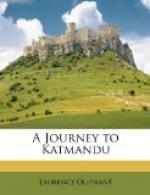CHAPTER XI.
The temple of Balajee—The old Newar capital—The houses and temples of Patn—View from the city gates—Nepaulese festivals—The Newars skilful artisans—The arsenal—The magazine and cannon-foundry.
One afternoon we strolled across some verdant meadows, and along narrow shady avenues, to visit the temple of Balajee. There is nothing in the building itself worthy of notice; but near it is a tank of beautifully clear water, filled with sacred fishes, which crowd near the visitor as he stands on the brink, expecting to be fed with grain, which some old women at the gate sell for their especial benefit. Balajee is one of those sheltered nooks which make the scenery of Nepaul so attractive. Immediately under a wooded knoll the trees dip into the tank, from whence the water leaps in three tiny cascades into the court-yard of the temple, quaint and singular itself, and rendered still more interesting from its connexion with the sacred fonts and groves near which it is so romantically situated.
Hitherto we had seen no Newar town. Katmandu, the capital of Nepaul, was built by the conquering Ghorkas, and is comparatively modern. The old Newar capital is Patn: situated on a green slope, and fortified by a high wall, it looks picturesque when seen from the modern city, from which it is distant about two miles.
Crossing the narrow brick bridge which spans the Bhagmutty, outside the walls of the town, we shortly after entered the massive old gates of the ancient capital. As we trotted past the high rickety houses, along the brick pavement of the narrow streets, still slippery from the morning dew, we encountered troops of girls with garlands in their hair, for this was some festive day. At the corners of the streets were beings of both sexes, as decrepit as the houses under which they crouched, presiding over baskets full of beautiful flowers. The entire population were Newars, except a few fierce mustachioed Ghorkas, who stood sentinels over the temples, or loitered about the guard-house. The long street looked deserted; there was not a single shop in it; and the foot-passengers were few and far between. But the grand square was the chief feature of the place, and was well worthy of a visit. We looked with astonishment and delight at the incongruous mass of buildings, of the most varied and fantastic construction, yet massive and substantial; but whence the designs originated, or in what other part of the known world anything is to be seen approaching to the style of Newar architecture, it would be impossible to conjecture. Houses built of horn are said to exist at Lassa; and from Lassa, I should imagine, came the designs for the temples and houses of Patn. Time has mellowed their bright colours—if they were ever painted at all like those at Katmandu—into a sombre, quiet grey. The Durbar, a huge, massive building, is




